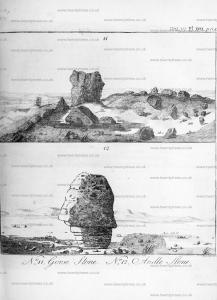Peak District Standing Stones
Peak District Standing Stones is in Prehistoric Peak District, Standing Stones.
Europe, British Isles, North-Central England, Derbyshire, Norbury, Stanton Moor, Andle Stone [Map]![]()
Andle Stone [Map]. A large boulder on Stanton Moor in Derbyshire.
Archaeologia Volume 6 Section XIII. Plate XVII. N° II. is a view of a stone called Gorse Stone [Map], with Cat Stone at a distance marked I. This name is undoubtedly derived from a British word gorsed dau (setting aloft). Doctor Borlace says, in his Antiquities of Cornwall, that the Druids had places of elevation "called gorsed dau; in some places they were made of earth, and sometimes they were upon high rocks, from whence they used to pronounce their decrees." Now no place seems to be better calculated for that purpose, or for their inaugurations, than these stones; the other, which is the largest of the three, is called Heart Stone [Map], and measures eighty-three feet in circumference.
N° 12. is a stone of a very singular fhape, called Andle Stone [Map]. It stands by itself on Stanton Moor, about a quarter of a mile north of Rowter; it seems to have been formed by art, and might probably have been a rock idol.

Europe, British Isles, North-Central England, Derbyshire, Norbury, Stanton Moor, King Stone [Map]![]()
Archaeologia Volume 6 Section XIII. Plate XV. N° 7. is a view or a Druid temple of nine stones on Stanton Moor [Map], about half a mile north of Rowter. It is called by the country people the Nine Ladies. At thirty-four yards west of the temple is a single stone [King Stone, Stanton Moor [Map]], which they have named the King. The diameter of the circle eleven yards; the stones are about two feet fix inches high.; there appears to have been one in the centre. Near it are several cairns; one had been opened a few years ago, and much rummaged: bones were found with a large blue glass bead with orifices not larger than the tip of a tobacco-pipe. One of these cairns 40 feet in diameter is engraved in Plate XVI a.